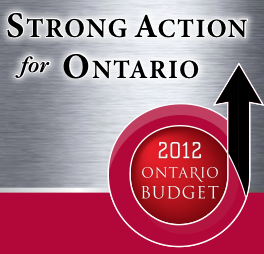Ontario’s Budget for 2012: What does it mean for Healthy Food and Farming
Posted: March 29, 2012
Categories: Food in the News / Ontario Food Policy

As we waited for Ontario Finance Minister Dwight Duncan to present the 2012 Ontario Budget yesterday, many of us were wondering what it would mean for food and farming. Would we see the budgets of the ministries and programs fundamental to our work cut? The Drummond Report recommended bolstering economic growth rates and increasing focus on health promotion. Would those translate into greater investment and focus on health promotion? What about building on the potential of the food and farming sector to create more jobs and generate economic development? Or would the budget-makers come down somewhere in the middle neither undermining our work nor advancing it to its full potential.
As many might have imagined the answer was right in the middle. The 2012 Ontario budget opens up a couple of opportunities to advance healthy food and farming systems, but mostly maintains the status quo.
Here’s what’s relevant to building healthy and sustainable food systems in the 2012 Ontario Provincial Budget:
- Social Assistance payments have been capped for the next year. Our friends, neighbours, and colleagues receiving social assistance will continue to struggle to afford healthy food. Demand for food banks may continue to increase over the coming year.
- The government has committed to creating a Jobs and Prosperity Fund and Council. The purpose of the fund is to support productivity growth and job creation in the business sector. The Council will provide advice to the government on consolidating and refocusing existing business support programs. For our sector, it will be important that, as Ontario’s largest employer, we are well represented on this council. We also need to make sure that our decision-makers (and those on the Council) know that we are a significant (the largest) employer and how much growth potential there is in our sector.
- Investment in Food and Agriculture through OMAFRA has been increased slightly. What those funds are going to be used for is not yet clear and the budget gives no indication other than capping business risk management program payouts at $100 million. While there are many on-going programs that OMAFRA will need to fund from their budget, there are also several programs that were part of the “Pick Ontario Freshness” program that have ended this year. Renewing or revising these programs and developing and implementing the promised Local Food Act will come from the renewed OMAFRA budget.
- Included in the budget for health care is implementing Ontario’s Action Plan for Health Care, which includes focusing on health promotion. However, though the Action Plan itself acknowledges that obesity has a direct effect on the rate of type 2 diabetes and the $4.9 billion it costs the province every year, the plan itself includes no plans to help adult Ontarians eat more healthily.
- Both the Action Plan for Health Care and the 2012 provincial budget both tout the development of a Childhood Obesity Strategy. The purpose of this strategy will be to reduce childhood obesity by 20 per cent over five years. The strategy is to be created by a panel of advocates, health care leaders, non-profit organizations, and industry. This strategy has significant potential. To realize its potential the right people need to be around the table. They need to be given enough leeway to develop a strategy that not only helps children to access and eat healthy food, but also makes sure that there is a food system that will enable them to continue to eat healthily.
- The Ministry of the Environment’s budget is being cut by $100 million. There is no indication in the budget of why that is, nor how those costs are going to be cut.
So what does this all mean for us?
*First, it means that the work that we are all doing together to create healthy, ecological, equitable and financially viable food systems will continue to receive a similar level of financial support – neither increased nor decreased. The possible exception is impacts as a result of cutting funding for the environment. The impacts of those cuts is unclear.
*Second, those Ontarians who receive social assistance will likely feel the pinch of spending caps, putting pressure on those of us in the emergency food sector and working in community-based food security programs.
*Finally, it means that we’ve got to keep in touch with our decision makers, our communities, our families and our friends, continuing to help Ontario understand that the food and farming sector offers solutions to help us become the thriving and vibrant Province that we can be.
